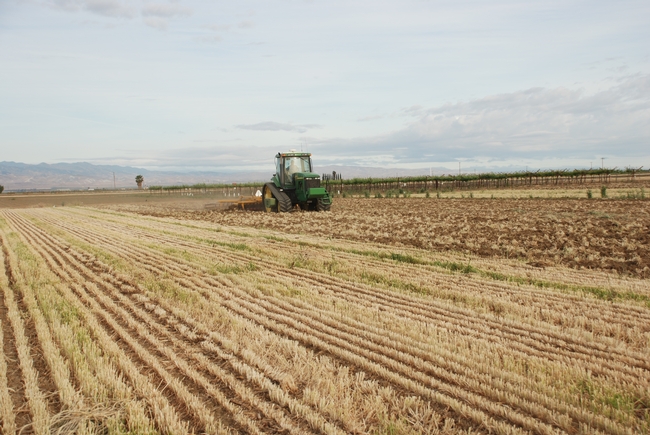Managing crop residues to essentially make them disappear has been the norm in California agriculture.
But a growing body of research, and experience with conservation tillage on thousands of acres of Central Valley farmland, is showing that reducing tillage and leaving crop residues on the soil surface can improve water use efficiency.
“Crop residues are an inevitable feature of agriculture,” Jeffrey Mitchell, cropping systems specialist in the Department of Plant Sciences, UC Davis, wrote in the April-June 2012 issue of California Agriculture journal. “Because no harvest removes all material from the field, the remaining plant matter accumulates and is typically returned to the soil through a series of mixing and incorporating operations involving considerable tractor horsepower, an array of tillage implements and cost.”
Conservation tillage is a suite of low-impact cultivation practices that includes leaving crop residues on the soil surface and planting new crops on top, significantly decreasing the number of tractor passes needed to prepare fields for planting. In turn, growers reduce their fuel, labor and maintenance costs, and less dust and pollution gets into the air.
In two field studies conducted at the UC West Side Research and Extension Center in Five Points, no-tillage and standard tillage operations were compared in a corn/wheat rotation. Mitchell and colleagues found that 0.89 and 0.97 inches more water was retained in the no-tillage soil than in the tilled soil.
And in three field studies on crop residue coverage, about 0.56, 0.58 and 0.42 inches more water was retained in residue-covered soil than in bare soil following 6 to 7 days of overhead sprinkler irrigation. The full study results are published in the April-June 2012 California Agriculture journal.
The authors estimated that coupling no-tillage with practices that preserve high residues on the soil surface can reduce evaporative losses during the summer by about 4 inches (13 percent), assuming a seasonal evapotranspiration demand of 30 inches.
In widespread use in other regions of the country, conservation tillage practices appear to be catching on in California. In surveys conducted by Sustainable Conservation and the UC Conservation Agriculture Systems Initiative, the amount of farmland under conservation tillage statewide grew by nearly 20 percent between 2008 and 2010, to about 1 million acres.
Mitchell and colleagues warn that a number of practical factors must be addressed before a wholesale transformation to no-tillage, residue-preserving production can be envisioned in California: “These include the relative ease with which a farm's existing cropping mix might be converted to no-till, the need for and cost of new equipment and the learning curve for new management practices.”
Attached Images:
